 The VIC-20 was a direct descendant of Commodore’s PET computer – popular with educators, school districts and students who, like myself, got their first computer experience on one of Commodore’s all-in-one monochrome machines of the future. The VIC-20 was, in fact, developed under the code-name of “Micro PET,” and it was designed to be the future in a convenient, compact, user-friendly package.
The VIC-20 was a direct descendant of Commodore’s PET computer – popular with educators, school districts and students who, like myself, got their first computer experience on one of Commodore’s all-in-one monochrome machines of the future. The VIC-20 was, in fact, developed under the code-name of “Micro PET,” and it was designed to be the future in a convenient, compact, user-friendly package.
It’s funny how that future kept changing. In 1981, when the VIC-20 was introduced by Commodore, America was in the thrall of video game mania, or at least more specifically Pac-Man mania. Atari’s star was rising, with no limit in sight; everyone and their  brother, it seemed, was getting into the business of arcade games, or making cartridges for the Atari 2600. New consoles were being developed. And the most bare-bones home computer setup could scarcely be had for $500. The Apple II was already around, certainly, but even the most basic Apple setup fetched nearly $1,500 at the time. Atari’s home computers and their competitors from Texas Instruments could be had for less than a thousand, but often in such bare-bones form that getting a more fully-featured computer setup would often bring the price point back up to a grand.
brother, it seemed, was getting into the business of arcade games, or making cartridges for the Atari 2600. New consoles were being developed. And the most bare-bones home computer setup could scarcely be had for $500. The Apple II was already around, certainly, but even the most basic Apple setup fetched nearly $1,500 at the time. Atari’s home computers and their competitors from Texas Instruments could be had for less than a thousand, but often in such bare-bones form that getting a more fully-featured computer setup would often bring the price point back up to a grand.
And then Commodore introduced the VIC-20. With a price tag lighter than $300 in most areas, and a retail network that included such outlets as Sears and Toys R Us, the VIC-20 may have also been bare-bones upon arrival – but for $300, it could afford to be. Optional items such as disk drives, printers and the blazing fast 300 baud VIC Modem could be added on, for a price, naturally. But for a basic machine that could give kids (and their parents) some hands-on computer learning experience, and a machine that could play colorful games to boot, $300 was an insanely competitive price point, and many consumers took Commodore up on the offer.
And the VIC-20 was surely the machine of the future. Its game cartridges – the software we’ll be focusing on the most in this archive – were vast chunks of plastic with an impressively wide connector that surely meant there was more program, or more fun – essentially, more value – going on than there was with a little thing like an Atari 2600 cartridge. The VIC-20’s all-in-one casing and easy hookup were certainly a sign of the future too. Surely this was how a home computer was meant to be.
Futuristic advertising was in order for Commodore’s wildly successful new computer as well. While his erstwhile Star Trek crewmate Leonard Nimoy extolled the virtues of the Odyssey² video game console in TV commercials, William Shatner endorsed the VIC-20, declaring it to be the computer of the future. Even with only 5K of on-board RAM (expandable with an add-on memory module), how could the VIC-20 not be the futuristic marvel that Captain Kirk himself described? And with major third-party software publishers like Imagic and Parker Brothers making games for the VIC, and even Atari’s own Atarisoft division porting popular Atari-licensed games, this was clearly a computer that would stick around. For the future.
Commodore introduced the Commodore 64 home computer a year later.
[jwcatpostlist orderby=title order=asc includecats=123]
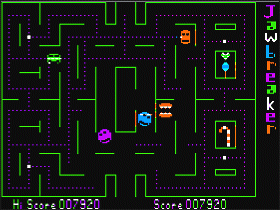 The Game: You’re a mobile set of chattering teeth, gobbling up goodies in a maze as jaw-breaking candies pursue you. If you bite down on one of these killer candies, you’ll rack up quite a dental bill (enough to lose a life). You can snag one of four snacks in the corners of the maze and suddenly the tooth-rotting treats become crunchy and vulnerable. Advance to the next level by clearing the maze of dots. (On-Line Systems, 1981)
The Game: You’re a mobile set of chattering teeth, gobbling up goodies in a maze as jaw-breaking candies pursue you. If you bite down on one of these killer candies, you’ll rack up quite a dental bill (enough to lose a life). You can snag one of four snacks in the corners of the maze and suddenly the tooth-rotting treats become crunchy and vulnerable. Advance to the next level by clearing the maze of dots. (On-Line Systems, 1981)
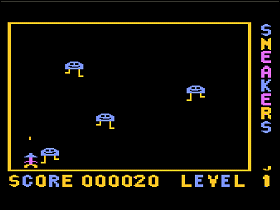 The Game: Alien invaders are descending on your world, taking on unusual forms in the process: sneaker-clad stomping creatures, roaming eyeballs, “H-wing fighters,” flying saucers and more. Try to use their unusual patterns of movement against them and keep them from destroying your fighter. (Sirius Software, 1981)
The Game: Alien invaders are descending on your world, taking on unusual forms in the process: sneaker-clad stomping creatures, roaming eyeballs, “H-wing fighters,” flying saucers and more. Try to use their unusual patterns of movement against them and keep them from destroying your fighter. (Sirius Software, 1981)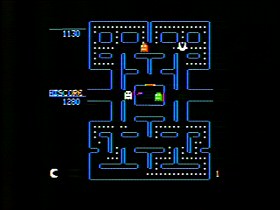 The Game: As a round white creature consisting of a mouth and nothing else, and apparently somehow tied to the Internal Revenue Service, you maneuver around a relatively simple maze, gobbling small dots and evading four colorful monsters who can eat you on contact. In four corners of the screen, large flashing dots enable you to turn the tables and eat the monsters for a brief period for an escalating score. Periodically, assorted items appear near the center of the maze, and you can consume these for additional points as well. The monsters, once eaten, return to their home base in ghost form and, after spending some noncorporeal time floating around and contemplating taxation without representation, return to chase you anew. If cleared of dots, the maze refills and the game starts again, but just a little bit faster… (H.A.L. Labs, 1981)
The Game: As a round white creature consisting of a mouth and nothing else, and apparently somehow tied to the Internal Revenue Service, you maneuver around a relatively simple maze, gobbling small dots and evading four colorful monsters who can eat you on contact. In four corners of the screen, large flashing dots enable you to turn the tables and eat the monsters for a brief period for an escalating score. Periodically, assorted items appear near the center of the maze, and you can consume these for additional points as well. The monsters, once eaten, return to their home base in ghost form and, after spending some noncorporeal time floating around and contemplating taxation without representation, return to chase you anew. If cleared of dots, the maze refills and the game starts again, but just a little bit faster… (H.A.L. Labs, 1981)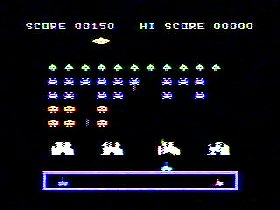 The Game: It’s quite simple, really. You’re the pilot of a ground-based mobile weapons platform, and there are buttloads of alien meanies headed right for you. Your only defense is a quartet of shields which are degraded by any weapons fire – yours or theirs – and a quick trigger finger. Occasionally a mothership zips across the top of the screen. When the screen is cleared of invaders, another wave – faster and more aggressive – appears. When you’re out of “lives,” or when the aliens manage to land on Earth…it’s all over. (Texas Instruments, 1981)
The Game: It’s quite simple, really. You’re the pilot of a ground-based mobile weapons platform, and there are buttloads of alien meanies headed right for you. Your only defense is a quartet of shields which are degraded by any weapons fire – yours or theirs – and a quick trigger finger. Occasionally a mothership zips across the top of the screen. When the screen is cleared of invaders, another wave – faster and more aggressive – appears. When you’re out of “lives,” or when the aliens manage to land on Earth…it’s all over. (Texas Instruments, 1981)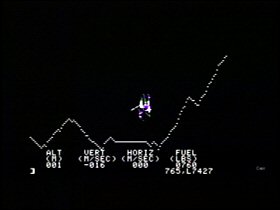 The Game: You are go for landing on the moon – only the moon isn’t there to make it easy for you. Craggy mountains and craters make it difficult for you to find one of the few safe landing spots on the surface, and even when you’re aligned above level ground, your fuel is running out fast. Do you have the right stuff that it’ll take before you can take one giant leap? (Bill Budge, 1981 / re-released by Eduware in 1984)
The Game: You are go for landing on the moon – only the moon isn’t there to make it easy for you. Craggy mountains and craters make it difficult for you to find one of the few safe landing spots on the surface, and even when you’re aligned above level ground, your fuel is running out fast. Do you have the right stuff that it’ll take before you can take one giant leap? (Bill Budge, 1981 / re-released by Eduware in 1984) The Game: As the pilot of a Bradley infantry fighting vehicle, you wander the desolate battlefield, trying to wipe out enemy tanks and helictopers without accidentally firing on your own allies. (Atari, under special contract for the United States Army, 1981)
The Game: As the pilot of a Bradley infantry fighting vehicle, you wander the desolate battlefield, trying to wipe out enemy tanks and helictopers without accidentally firing on your own allies. (Atari, under special contract for the United States Army, 1981)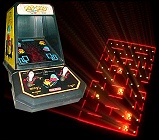 The Game: As a round yellow creature consisting of a mouth and nothing else, you maneuver around a relatively simple maze, gobbling small yellow dots and evading four monsters who can eat you on contact. In four corners of
The Game: As a round yellow creature consisting of a mouth and nothing else, you maneuver around a relatively simple maze, gobbling small yellow dots and evading four monsters who can eat you on contact. In four corners of 
 The VIC-20 was a direct descendant of Commodore’s PET computer – popular with educators, school districts and students who, like myself, got their first computer experience on one of Commodore’s all-in-one monochrome machines of the future. The VIC-20 was, in fact, developed under the code-name of “Micro PET,” and it was designed to be the future in a convenient, compact, user-friendly package.
The VIC-20 was a direct descendant of Commodore’s PET computer – popular with educators, school districts and students who, like myself, got their first computer experience on one of Commodore’s all-in-one monochrome machines of the future. The VIC-20 was, in fact, developed under the code-name of “Micro PET,” and it was designed to be the future in a convenient, compact, user-friendly package.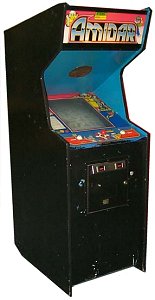 The Game: I’ll try to explain this as best I can. You’re a paintroller (recent escapee from Make Trax?) beseiged by pigs. Or a gorilla pursued by natives. Or something like that. It depends on which level you’re playing. You must try to enclose as many of the spaces in the game area as possible, in a zig-zagging pattern. This, the attract mode wisely advises us, is “Amidar movement.” You have one way to avoid an imminent head-on collision – you can hit the jump button, which doesn’t make you jump, but forces everything else on the board to jump. Enclosing all of the available spaces advances you to the next level, with different animal enemies. (Stern [under license from Konami], 1982)
The Game: I’ll try to explain this as best I can. You’re a paintroller (recent escapee from Make Trax?) beseiged by pigs. Or a gorilla pursued by natives. Or something like that. It depends on which level you’re playing. You must try to enclose as many of the spaces in the game area as possible, in a zig-zagging pattern. This, the attract mode wisely advises us, is “Amidar movement.” You have one way to avoid an imminent head-on collision – you can hit the jump button, which doesn’t make you jump, but forces everything else on the board to jump. Enclosing all of the available spaces advances you to the next level, with different animal enemies. (Stern [under license from Konami], 1982) The Game: Help Mr. F. Lea get to the top in this dog-eat-dog world. Cross a treacherous yard full of lawn-mowers (and helpfully slow-moving dogs), swing from tail to tail until you’ve jumped on every dog on the screen, scale the big dog’s back and jump over his spots, and climb to the top of Dog Hollow while avoiding the dog toys and bones being thrown at you from the top of the screen. You’d better be itching to win. (Pacific Novelty, 1982)
The Game: Help Mr. F. Lea get to the top in this dog-eat-dog world. Cross a treacherous yard full of lawn-mowers (and helpfully slow-moving dogs), swing from tail to tail until you’ve jumped on every dog on the screen, scale the big dog’s back and jump over his spots, and climb to the top of Dog Hollow while avoiding the dog toys and bones being thrown at you from the top of the screen. You’d better be itching to win. (Pacific Novelty, 1982)  The Game: You’re a thief trying to make away with all the loot buried in a complex maze of interconnected mines and shafts, and you’d get away with it if it weren’t for some pesky cops who are hot on your trail. You can drop bags of money on them from a level above, or temporarily brain them with a pick, and they’ll occasionally also bumble into open mine shafts of their own accord. In any of these events, they vanish for a little while to recover before reappearing. But any of these things will do you in too! (Stern/Seeburg [under license from Valadon Automation], 1982)
The Game: You’re a thief trying to make away with all the loot buried in a complex maze of interconnected mines and shafts, and you’d get away with it if it weren’t for some pesky cops who are hot on your trail. You can drop bags of money on them from a level above, or temporarily brain them with a pick, and they’ll occasionally also bumble into open mine shafts of their own accord. In any of these events, they vanish for a little while to recover before reappearing. But any of these things will do you in too! (Stern/Seeburg [under license from Valadon Automation], 1982) The Game: You are the intrepid, barbershop-quartet-suited J.J. (hey, it’s better than being O.J.!), out to save a damsel in distress from a pursuing monster. How does a guy in a little striped suit do this? By building a mobile, tennis-ball-launching contraption to dispatch said dastardly monster, naturally. The catch? The eight pieces of your mechanical creation are hidden somewhere among ten little houses in a maze – and those houses that don’t contain parts of your machine contain a bomb that must be dumped into the bomb pit immediately (else they’ll explode and kill J.J.). Critters also roam the maze to annoy you, including one pesky monster who will prematurely jump on the “start” button, rattling your still-unfinished machine to bits. If you don’t build your Rube Goldberg gizmo in time, the monster catches the damsel and you lose a life. (Bally/Midway, 1982)
The Game: You are the intrepid, barbershop-quartet-suited J.J. (hey, it’s better than being O.J.!), out to save a damsel in distress from a pursuing monster. How does a guy in a little striped suit do this? By building a mobile, tennis-ball-launching contraption to dispatch said dastardly monster, naturally. The catch? The eight pieces of your mechanical creation are hidden somewhere among ten little houses in a maze – and those houses that don’t contain parts of your machine contain a bomb that must be dumped into the bomb pit immediately (else they’ll explode and kill J.J.). Critters also roam the maze to annoy you, including one pesky monster who will prematurely jump on the “start” button, rattling your still-unfinished machine to bits. If you don’t build your Rube Goldberg gizmo in time, the monster catches the damsel and you lose a life. (Bally/Midway, 1982) The Game: Players guide a caterpillar around a maze of twigs and branches, snatching up nourishment and the occasional treat, and avoiding other insect life; some parts of the branches can be turned. Some of the treats will allow the caterpillar to consume other insects for a brief time. Portions of the maze can be rotated, which can work against the player (cutting off the best or only escape route) or can work to the player’s advantage (effectively shutting a door in pursuers’ faces, or even smashing them if they’re in the wrong place at the right time). Clearing the maze allows the caterpillar to turn into a butterfly and escape (who needs a pupal stage anyway?); the player advances to the next level, where a new caterpillar needs help navigating a new maze. (Orca, 1982)
The Game: Players guide a caterpillar around a maze of twigs and branches, snatching up nourishment and the occasional treat, and avoiding other insect life; some parts of the branches can be turned. Some of the treats will allow the caterpillar to consume other insects for a brief time. Portions of the maze can be rotated, which can work against the player (cutting off the best or only escape route) or can work to the player’s advantage (effectively shutting a door in pursuers’ faces, or even smashing them if they’re in the wrong place at the right time). Clearing the maze allows the caterpillar to turn into a butterfly and escape (who needs a pupal stage anyway?); the player advances to the next level, where a new caterpillar needs help navigating a new maze. (Orca, 1982)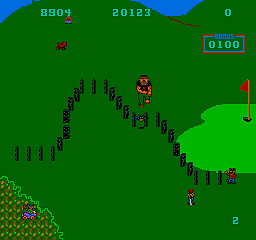 The Game: The town square or the local golf course seems like a reasonable place to set up a huge row of dominoes, doesn’t it? Well, your on-screen protagonist sure seems to think so, and your job is to help him set up his dominoes without allowing any of a number of on-screen “enemies” – such as absent-minded shoppers pushing carts, bees, or a bemuscled bonehead – to knock the dominoes over. (Bally/Midway, 1982)
The Game: The town square or the local golf course seems like a reasonable place to set up a huge row of dominoes, doesn’t it? Well, your on-screen protagonist sure seems to think so, and your job is to help him set up his dominoes without allowing any of a number of on-screen “enemies” – such as absent-minded shoppers pushing carts, bees, or a bemuscled bonehead – to knock the dominoes over. (Bally/Midway, 1982) The Game: As commander of the three-stage fighter rocket Eagle, your job is to ward off endless varieties of evasively weaving space attackers. Every time you knock out two consecutive screens of assailants, you’ll have an opportunity to dock your ship to another one of Eagle’s three stages, until all three portions of the ship are combined to create one bad-ass weapons platform. But you can also lose stages very quickly, ending your game – a bigger ship makes a bigger and easier target. (Centuri [under license from Nichibutsu], 1982)
The Game: As commander of the three-stage fighter rocket Eagle, your job is to ward off endless varieties of evasively weaving space attackers. Every time you knock out two consecutive screens of assailants, you’ll have an opportunity to dock your ship to another one of Eagle’s three stages, until all three portions of the ship are combined to create one bad-ass weapons platform. But you can also lose stages very quickly, ending your game – a bigger ship makes a bigger and easier target. (Centuri [under license from Nichibutsu], 1982) The Game: Don’t take this personally, but you’re a yo-yo in The Electric Yo-Yo, trying to clear all the dots from the screen and trying just as hard to avoid the bug-eyed monsters and other enemies who seem to be natural predators of toys on strings. You must plan your movement around the screen carefully – the further you can move in a straight line to eliminate the most dots, the faster you’ll move.
The Game: Don’t take this personally, but you’re a yo-yo in The Electric Yo-Yo, trying to clear all the dots from the screen and trying just as hard to avoid the bug-eyed monsters and other enemies who seem to be natural predators of toys on strings. You must plan your movement around the screen carefully – the further you can move in a straight line to eliminate the most dots, the faster you’ll move. 
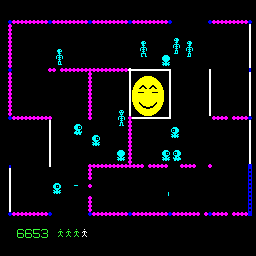 The Game: You’re back in the maze, but this time, the stakes are increased, the danger is increased, and your strategic options are only slightly increased. Touching the walls, the robots, the robots’ laser blasts, or even your own ricocheted lasers are deadly. And of course, the inevitable appearance by Evil Otto is also deadly. However, you can temporarily repel the smiley little bugger by blasting him until his grin turns into the frown – but he will reappear mere seconds later, moving much faster every time he must retreat and reappear – so you’re not doing yourself any favors. If you enter a generator room, you can halt all the robots in their tracks by penetrating the walls surrounding the generator and blasting it. “Beaded” walls can be eaten away, bit by bit, by laser fire from anyone who shoots it, while solid walls will ricochet lasers around until they hit something – which could mean a death trap for you. (Stern, 1982)
The Game: You’re back in the maze, but this time, the stakes are increased, the danger is increased, and your strategic options are only slightly increased. Touching the walls, the robots, the robots’ laser blasts, or even your own ricocheted lasers are deadly. And of course, the inevitable appearance by Evil Otto is also deadly. However, you can temporarily repel the smiley little bugger by blasting him until his grin turns into the frown – but he will reappear mere seconds later, moving much faster every time he must retreat and reappear – so you’re not doing yourself any favors. If you enter a generator room, you can halt all the robots in their tracks by penetrating the walls surrounding the generator and blasting it. “Beaded” walls can be eaten away, bit by bit, by laser fire from anyone who shoots it, while solid walls will ricochet lasers around until they hit something – which could mean a death trap for you. (Stern, 1982) The Game: In a very genteel and almost inappropriately cute game about armored combat, you’re a lone footsoldier fighting your way through a platoon of enemy troops, trying to take out as many of them as you can until you find your way to a handy empty tank. (Nice of the enemy to allow your government to plant friendly tanks behind their borders, isn’t it?) But once you man your own tank, enemy tanks surround you. If one of them hits your tank, you have mere seconds to bail out before your tank blows, and you have to dodge cannon fire until you can find another friendly tank to commandeer. Finally, after crossing hazardous stretches of desert and fighting off entire battallions of enemy tanks, you’re en route to the final confrontation, a showdown with the enemy’s armored headquarters… (Taito, 1982)
The Game: In a very genteel and almost inappropriately cute game about armored combat, you’re a lone footsoldier fighting your way through a platoon of enemy troops, trying to take out as many of them as you can until you find your way to a handy empty tank. (Nice of the enemy to allow your government to plant friendly tanks behind their borders, isn’t it?) But once you man your own tank, enemy tanks surround you. If one of them hits your tank, you have mere seconds to bail out before your tank blows, and you have to dodge cannon fire until you can find another friendly tank to commandeer. Finally, after crossing hazardous stretches of desert and fighting off entire battallions of enemy tanks, you’re en route to the final confrontation, a showdown with the enemy’s armored headquarters… (Taito, 1982) The Game: Players control the Jolly Jogger as he attempts to draw borders around every square area on the playing field. There are several special squares which temporarily give Jolly Jogger the ability to freeze his pursuers for a while; at all other times, they are to be avoided at all costs. Running around every square on the screen clears that level and introduces a new maze of squares where the process begins anew. A lit fuse counts down the time available to Jolly Jogger to complete each screen; if time runs out, a life is lost. (Taito, 1982)
The Game: Players control the Jolly Jogger as he attempts to draw borders around every square area on the playing field. There are several special squares which temporarily give Jolly Jogger the ability to freeze his pursuers for a while; at all other times, they are to be avoided at all costs. Running around every square on the screen clears that level and introduces a new maze of squares where the process begins anew. A lit fuse counts down the time available to Jolly Jogger to complete each screen; if time runs out, a life is lost. (Taito, 1982)
 The Game: You are the king of the jung…uh, pirate ship! Swinging from rope to rope! Swimming through shark-infested waters! Jumping and ducking huge rolling boulders! And vanquishing knive-weilding pirates (wait, aren’t they supposed to be on your side if you’re a pirate too?) to rescue the damsel! (Taito, 1982)
The Game: You are the king of the jung…uh, pirate ship! Swinging from rope to rope! Swimming through shark-infested waters! Jumping and ducking huge rolling boulders! And vanquishing knive-weilding pirates (wait, aren’t they supposed to be on your side if you’re a pirate too?) to rescue the damsel! (Taito, 1982) The Game: This is a game about the rough-and-tumble history of the taming of the North American continent, as told by someone who’s never been allowed access to any kind of reading material at all. You pilot a balloon across a scrolling landscape, avoiding (or blasting) birds and bombing a convoy of covered wagons. After conquering this level, you move on to a village of boomerang-throwing natives (and hey, early America was just thick with those puppies, wasn’t it?), followed by coconut-hurling gorillas (another prominent feature on the landscape of the early United States). A brief stage follows in which you must evade a series of random tornadoes, and then you have more wagons to bomb. At least they got something right – there are tornadoes in the U.S. (Rock-Ola [under license from SNK], 1982)
The Game: This is a game about the rough-and-tumble history of the taming of the North American continent, as told by someone who’s never been allowed access to any kind of reading material at all. You pilot a balloon across a scrolling landscape, avoiding (or blasting) birds and bombing a convoy of covered wagons. After conquering this level, you move on to a village of boomerang-throwing natives (and hey, early America was just thick with those puppies, wasn’t it?), followed by coconut-hurling gorillas (another prominent feature on the landscape of the early United States). A brief stage follows in which you must evade a series of random tornadoes, and then you have more wagons to bomb. At least they got something right – there are tornadoes in the U.S. (Rock-Ola [under license from SNK], 1982)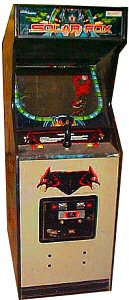 The Game: Your ship is confined to a grid-like playing field, which isn’t all that bad until you take into account that armed ships are gliding along all four of the “walls” surrounding that grid, blasting away at you like a fish in a barrel. Your job is the clear the grid of the objects filling it, and wherever possible, to fire a well-timed shot at the ships trying to destroy you. Clearing the grid advances you to the next level. (Bally/Midway, 1982)
The Game: Your ship is confined to a grid-like playing field, which isn’t all that bad until you take into account that armed ships are gliding along all four of the “walls” surrounding that grid, blasting away at you like a fish in a barrel. Your job is the clear the grid of the objects filling it, and wherever possible, to fire a well-timed shot at the ships trying to destroy you. Clearing the grid advances you to the next level. (Bally/Midway, 1982) The Game: Super Mouse is on the case. He’s trying to grab all the food from every level of the screen. While he’s on the case, cats are on the chase, trying to catch Super Mouse. Two blocks of cheese on the top levels of the screen can be dropped on top of the cats, or the cats can be tricked into chasing Super Mouse over a trap door that’ll dump them in a water tank. But the cats don’t stay gone for long. Super Mouse advances to a new level when he takes every piece of food back to his secret hideout. (Taito, 1982)
The Game: Super Mouse is on the case. He’s trying to grab all the food from every level of the screen. While he’s on the case, cats are on the chase, trying to catch Super Mouse. Two blocks of cheese on the top levels of the screen can be dropped on top of the cats, or the cats can be tricked into chasing Super Mouse over a trap door that’ll dump them in a water tank. But the cats don’t stay gone for long. Super Mouse advances to a new level when he takes every piece of food back to his secret hideout. (Taito, 1982)
 The Game: As the conductor of a time-traveling train, you must find and collect your passenger cars in the present day, move on to the near future to pull up to several stations and fill those cars with time travelers, and then deposit them at various attractions in the distant future. That would be difficult enough to do without running out of fuel, but you also have to contend with space creatures and repeatedly avoid collisions with a competing train by controlling the switches on the tracks. (1982, Taito)
The Game: As the conductor of a time-traveling train, you must find and collect your passenger cars in the present day, move on to the near future to pull up to several stations and fill those cars with time travelers, and then deposit them at various attractions in the distant future. That would be difficult enough to do without running out of fuel, but you also have to contend with space creatures and repeatedly avoid collisions with a competing train by controlling the switches on the tracks. (1982, Taito) The Game: Piloting a ship navigating a tunnel in space at breakneck speeds, your mission – aside from screaming down that tunnel way over the speed limit without getting too far off course- is to dispatch countless suspiciously bow-tie-shaped fighters before they get a clear shot at you. (Has anyone ever wondered what all these short-range fighters are doing out here? Bah, never mind. Probably got separated from a convoy or something.) If the enemy ships do manage to get a shot off, you have a narrow window of opportunity in which to intercept the incoming laser fire – very narrow, considering how fast everything is moving. Fire too much, and your lasers overheat and become temporarily useless. Stray too far off course, and your hull temperature shoots upward until your ship explodes. (Atari, 1979 – released by Centuri in 1982)
The Game: Piloting a ship navigating a tunnel in space at breakneck speeds, your mission – aside from screaming down that tunnel way over the speed limit without getting too far off course- is to dispatch countless suspiciously bow-tie-shaped fighters before they get a clear shot at you. (Has anyone ever wondered what all these short-range fighters are doing out here? Bah, never mind. Probably got separated from a convoy or something.) If the enemy ships do manage to get a shot off, you have a narrow window of opportunity in which to intercept the incoming laser fire – very narrow, considering how fast everything is moving. Fire too much, and your lasers overheat and become temporarily useless. Stray too far off course, and your hull temperature shoots upward until your ship explodes. (Atari, 1979 – released by Centuri in 1982)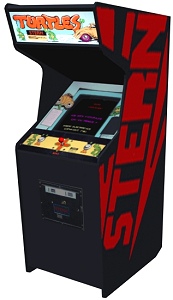 The Game: You are the Mama Turtle. Your helpless KidTurtles are stuck in a high-rise building, hiding from mean and hungry beetles. The beetles change colors in accordance with their speed and ferocity, from less aggressive green and blue beetles to fast, furious yellow and red beetles. Mama Turtle has to evade the beetles (which are deadly to touch at all times) and touch the mystery squares throughout the maze. The squares could reveal another beetle, or they could reveal one of the KidTurtles. When Mama Turtle picks up a KidTurtle, a safe house appears – usually all the way across the maze – and she must deposit the KidTurtles in the safe house, one at a time. Mama Turtle’s only recourse against the beetles is to lay “bombs” in the maze. Each bomb – and there can only be one on screen at a time – will reduce the first beetle that hits it back to the lowest speed/danger level, buying Mama Turtle a little time. (Mama Turtle can pass over her own bombs harmlessly.) The catch? You only start out with three bombs (is anyone else drawing some grim biological anologies to what Mama Turtle’s “bombs” might be at this point?), and you can replenish your supply of bombs only by running over an occasional flashing symbol which appears at the precise center of the maze…which is usually the most dangerous spot on the screen. Clearing a maze of KidTurtles allows you to climb to the next floor of the building and start anew. (Stern [under license from Konami], 1982)
The Game: You are the Mama Turtle. Your helpless KidTurtles are stuck in a high-rise building, hiding from mean and hungry beetles. The beetles change colors in accordance with their speed and ferocity, from less aggressive green and blue beetles to fast, furious yellow and red beetles. Mama Turtle has to evade the beetles (which are deadly to touch at all times) and touch the mystery squares throughout the maze. The squares could reveal another beetle, or they could reveal one of the KidTurtles. When Mama Turtle picks up a KidTurtle, a safe house appears – usually all the way across the maze – and she must deposit the KidTurtles in the safe house, one at a time. Mama Turtle’s only recourse against the beetles is to lay “bombs” in the maze. Each bomb – and there can only be one on screen at a time – will reduce the first beetle that hits it back to the lowest speed/danger level, buying Mama Turtle a little time. (Mama Turtle can pass over her own bombs harmlessly.) The catch? You only start out with three bombs (is anyone else drawing some grim biological anologies to what Mama Turtle’s “bombs” might be at this point?), and you can replenish your supply of bombs only by running over an occasional flashing symbol which appears at the precise center of the maze…which is usually the most dangerous spot on the screen. Clearing a maze of KidTurtles allows you to climb to the next floor of the building and start anew. (Stern [under license from Konami], 1982) The Game: You control a hapless creature who can jump between rows of moving bricks and even temporarily build a brick around himself. You’re trying to help him gather gifts for Lola, the object of his desires, at the opposite end of the screen; she won’t even pay attention to you until you’ve accumulated a certain number of gifts for her. (Demanding, isn’t she? I can hear Dr. Phil screaming “Stay away from her! She’s bad for you!” already.) Other than Lola’s curiously materialistic outlook on life, your biggest obstacles are colorful critters who would happily jump on you and end your quest. You can hide from them temporarily by building a brick around yourself, but if they catch you, it’s time to start over again. (Cinematronics, 1982)
The Game: You control a hapless creature who can jump between rows of moving bricks and even temporarily build a brick around himself. You’re trying to help him gather gifts for Lola, the object of his desires, at the opposite end of the screen; she won’t even pay attention to you until you’ve accumulated a certain number of gifts for her. (Demanding, isn’t she? I can hear Dr. Phil screaming “Stay away from her! She’s bad for you!” already.) Other than Lola’s curiously materialistic outlook on life, your biggest obstacles are colorful critters who would happily jump on you and end your quest. You can hide from them temporarily by building a brick around yourself, but if they catch you, it’s time to start over again. (Cinematronics, 1982)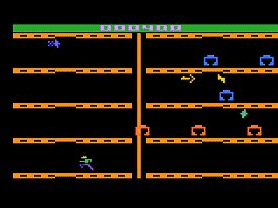 The Game: As video warrior Tron, you scale the heights of the MCP’s domain, avoiding Tanks, Recognizers and Grid Bugs, and trying to collect Bits. You can occasionally hitch a brief ride on a perpetually airborne Solar Sailer on one level, allowing you to fly over your opponents’ heads for a few seconds. (M Network [Mattel], 1982)
The Game: As video warrior Tron, you scale the heights of the MCP’s domain, avoiding Tanks, Recognizers and Grid Bugs, and trying to collect Bits. You can occasionally hitch a brief ride on a perpetually airborne Solar Sailer on one level, allowing you to fly over your opponents’ heads for a few seconds. (M Network [Mattel], 1982)